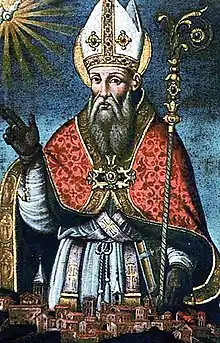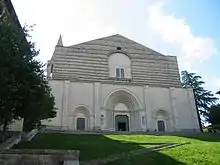Fortunatus of Todi
Saint Fortunatus (died 537) was a 6th-century bishop of Todi.[1] According to tradition, he defended Todi during a Gothic siege.[2] He is the patron saint of Todi.
Saint Fortunatus of Todi | |
|---|---|
 | |
| Died | 537 |
| Venerated in | Roman Catholic Church |
| Major shrine | San Fortunato, Todi |
| Feast | October 14 |
| Patronage | Todi |
Life
Fortunatus came to Italy from Poitiers as a hermit. Because of his miracles and ability to cast out demons, in 528 he was urged by the clergy and the people to become bishop. His predecessor, Callistus (c. 502-28), had been killed by the Goths. The first cathedral was the church of Sant'Ilario.[3]
Fortunatus saved the city from being sacked by the Ostrogoths. He converted many and destroyed a temple to the god Pan and used the materials to build a church.[4] Fortunatus consecrated the church.of San Fortunato, where his bones are preserved. A Benedictine monastery was attached to it in the 11th century. The altars to Fortunatus and Cassianus of Imola were consecrated by Pope Innocent III in 1198.[3]
He is praised by Gregory the Great, who calls him a man of great virtue who took great care in attending to the sick.[5] Gregory, who was born around the time that Fortunatus died, was greatly interested in Fortunatus' life. Gregory writes that "a certain poor old man was brought to me –because I always love to talk with such men- of whom I inquired his country, and hearing that he was of the city of Todi, I asked him whether he knew Bishop Fortunatus. He said he knew him very well. 'Then I beseech you,' said I, 'tell me whether you know of any miracles that he did, and, since I am very desirous to know, explained to me what manner of man he was.'"[6]
Veneration
The church of San Fortunato in Todi is dedicated to him and holds his relics. San Fortunato began as a Palaeo-Christian temple (7th century) and in 1292 the construction of a new Gothic edifice was begun by the Franciscans, with a "hall" structure. The crypt houses a sepulchre containing the remains of Fortunatus and other saints, as well as the tomb of Jacopone da Todi.
 Church of San Fortunato
Church of San Fortunato Church of San Fortunato
Church of San Fortunato
References
- St. Fortunatus of Todi, retrieved 2012-11-04
- Latin Saints of the Orthodox Patriarchate of Rome, retrieved 2012-11-04
- Schäfer, Joachim "Fortunatus of Todi", Ecumenical Encyclopedia of Saints
- Odden, Per Einer. "Den hellige Fortunatus av Todi (d. 537)", Den katolske kirke, December 28, 2015
- San Fortunato di Todi [Saint Fortunato of Todi] (in Italian), retrieved 2012-11-04
- Dudden, Frederick (1905), Gregory the Great, vol. 2, London: Longmans Green, p. 339, OCLC 914226